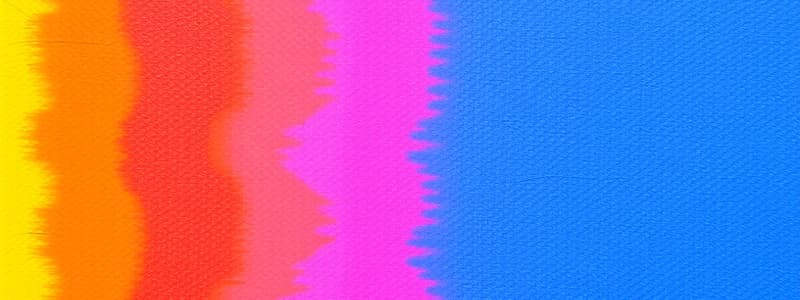Podcast
Questions and Answers
What is the definition of color?
What is the definition of color?
- The optical effect caused when reflected white light of the spectrum is divided into a separate wavelength (correct)
- The lightness or darkness of a plane or area
- Three basic colors from which all others are derived
- A flat surface
What are the three primary colors?
What are the three primary colors?
Red, Yellow, Blue
What defines secondary colors?
What defines secondary colors?
- Colors made by mixing complementary hues
- Vivid colors used in early 20th century French art
- Colors lighter than their purest state
- Colors mixed from two primary colors (correct)
What is a pigment?
What is a pigment?
What is Hue?
What is Hue?
What does Value refer to in terms of color?
What does Value refer to in terms of color?
What is a Tint?
What is a Tint?
What is a Shade?
What is a Shade?
What are Neutral colors?
What are Neutral colors?
What does Monochromatic mean?
What does Monochromatic mean?
What is Cubism?
What is Cubism?
What is Collage?
What is Collage?
What is a Palette?
What is a Palette?
What is Style in art?
What is Style in art?
What does Saturation refer to in color theory?
What does Saturation refer to in color theory?
What is a Plane?
What is a Plane?
Who are the Fauves?
Who are the Fauves?
What are Complementary Colors?
What are Complementary Colors?
What are Analogous Colors?
What are Analogous Colors?
What is Impressionism?
What is Impressionism?
What does Temperature refer to in color theory?
What does Temperature refer to in color theory?
What is Ground in the context of art?
What is Ground in the context of art?
What is Pointillism?
What is Pointillism?
What does Medium refer to in art?
What does Medium refer to in art?
Flashcards are hidden until you start studying
Study Notes
Color Concepts
- Color is the optical effect from reflecting white light, divided into separate wavelengths in the spectrum.
- Primary colors are the foundational colors: Red, Yellow, and Blue, used to create other colors.
- Secondary colors arise by mixing two primary colors together.
- Pigments are colored materials, typically ground minerals, used in creating paints.
- Hue refers to the classification of color, distinguishing characteristics visible within the spectrum, like green or red.
- Value indicates the lightness or darkness of a color in a given area.
Color Variations
- A tint is a color that has been lightened from its pure state.
- A shade is a color that has been darkened from its pure state.
- Neutrals consist of blacks, whites, grays, and dull gray-browns, typically formed by mixing complementary hues.
- Monochromatic refers to using one color in different values or shades.
- Saturation measures the purity and intensity of a color.
Art Movements and Techniques
- Cubism, a 20th-century art movement, emphasizes geometric forms and new perspectives in art.
- Collage, derived from the French word "coller," involves assembling materials like paper on a surface to create art.
- A palette describes the variety of colors an artist employs in their work.
- Style denotes a specific way artists use visual language to create recognizable forms in their work.
Color Relationships
- Complementary colors are located opposite each other on the color wheel, providing contrast.
- Analogous colors are hues that are next to one another on the color wheel, often used for harmonious compositions.
Artistic Styles and Principles
- Impressionism is a late 19th-century painting style focused on capturing light's effects.
- Temperature in color defines associations with coolness or warmth, impacting emotional responses.
- Ground refers to the surface or background where an artist paints or draws.
- Pointillism, a technique from the late 19th century, employs short strokes or dots of color which visually blend at a distance.
- Medium encompasses the materials used to create art, such as oil on canvas, marble, or digital forms.
Historical Movements
- Fauves were a group of French artists in the early 20th century noted for their use of bold, vivid colors.
Studying That Suits You
Use AI to generate personalized quizzes and flashcards to suit your learning preferences.


